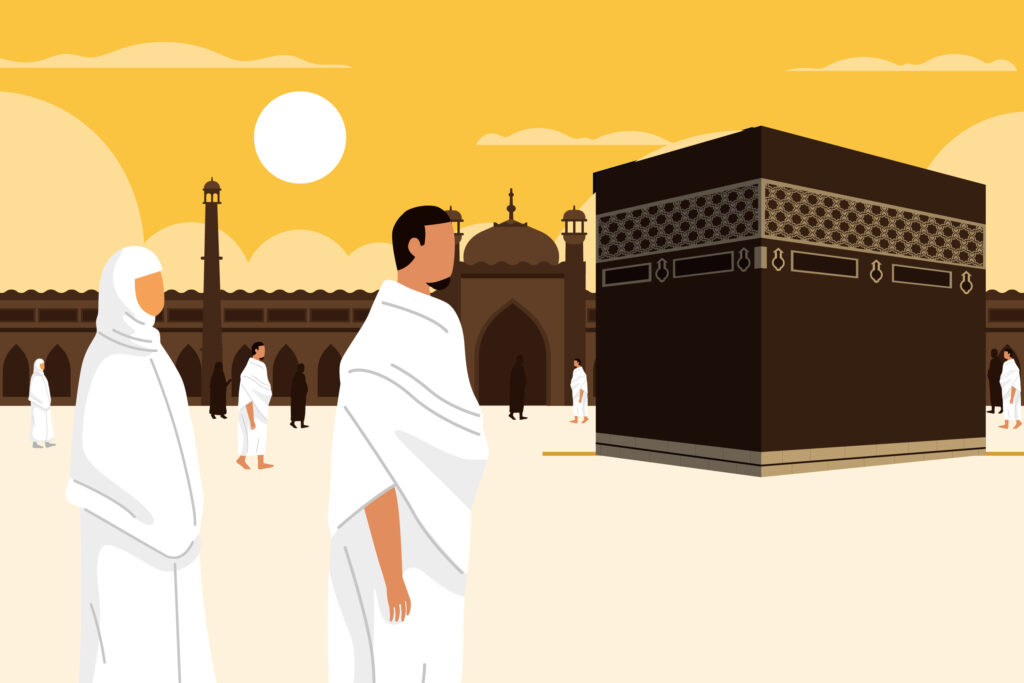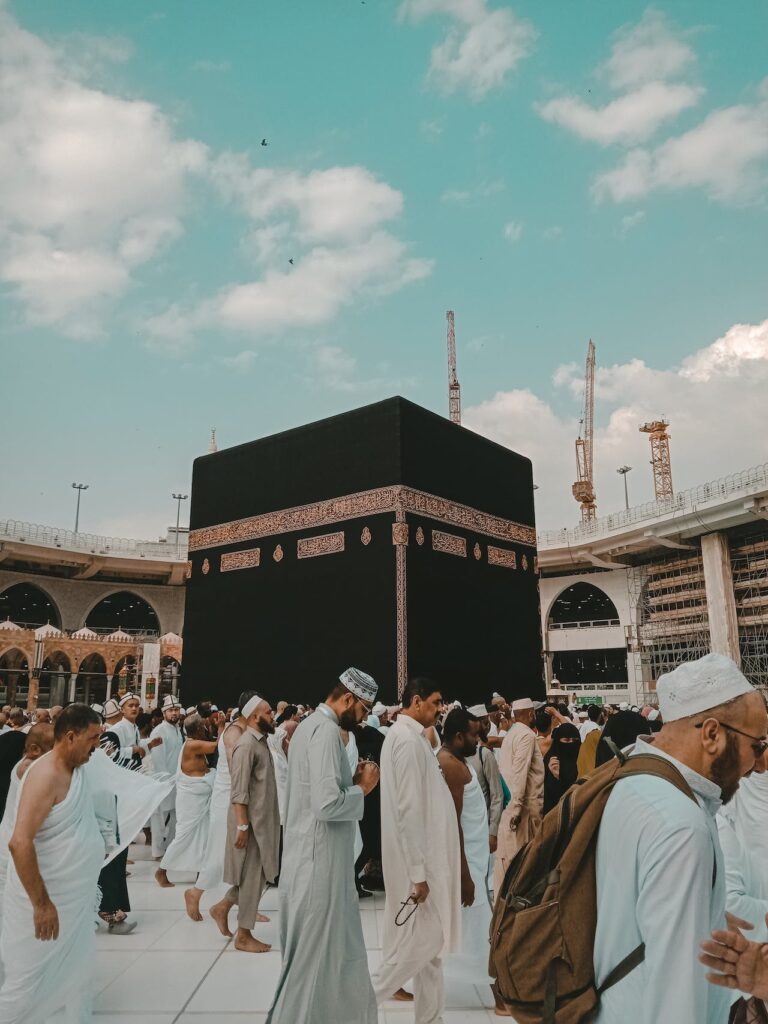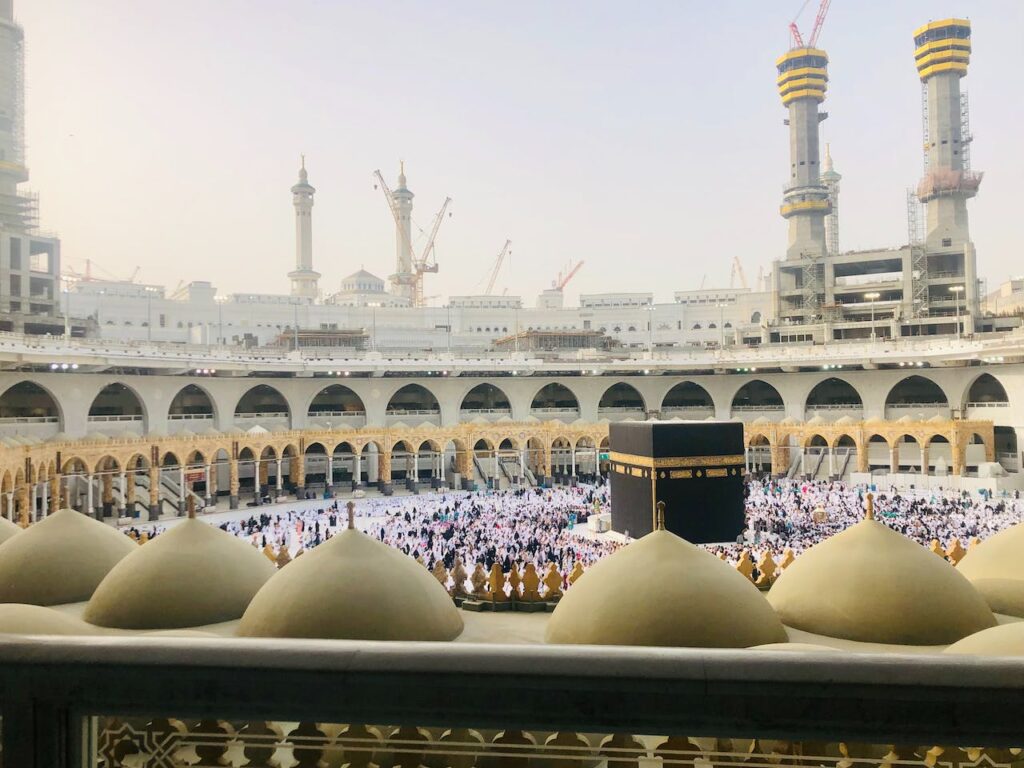In this article, we will explore the history of Tawaf, its origins, its significance in Islamic sources, and its development over the centuries.
The History of Tawaf
The history of Tawaf dates back to pre-Islamic times when the Kaaba was already a place of pilgrimage for the Arab tribes.
The origins of Tawaf can be traced to the time of Prophet Ibrahim (Abraham) and his son Ismail (Ishmael),
who is believed to have built the Kaaba as a house of worship dedicated to the worship of the One True God.
“And when Ibrahim was raising the foundations of the House and Ismail, [they prayed], ‘Our Lord, accept [this] from us. Indeed, You are the Hearing, the Knowing.'”[Al-Baqara:127]
وَإِذْ يَرْفَعُ إِبْرَاهِيمُ الْقَوَاعِدَ مِنَ الْبَيْتِ وَإِسْمَاعِيلُ رَبَّنَا تَقَبَّلْ مِنَّا ۖ إِنَّكَ أَنْتَ السَّمِيعُ الْعَلِيمُ
[البقرة: 127]
The practice of Tawaf, as we know it today, began with the advent of Islam and the proclamation of the Prophet Muhammad (pbuh)
as the final messenger of Allah. The Kaaba was cleansed of the idols that had been placed inside it
and rededicated as a place of monotheistic worship.
In the early days of Islam, Tawaf was performed by the Prophet Muhammad (pbuh) and his companions.
They would circle the Kaaba, recite prayers, and engage in acts of devotion and remembrance of Allah.
The rituals of Tawaf were prescribed by Allah through the Quran, and the Prophet Muhammad (pbuh)
provided guidance on the specific actions and supplications to be performed during Tawaf.
Moreover, Over the centuries, Tawaf evolved and developed as Islam spread to different regions of the world.
The practice of Tawaf became an integral part of the Hajj pilgrimage, which attracts millions of Muslims from around the globe every year.
Today, Tawaf is performed in the same manner as it was during the time of the Prophet Muhammad (pbuh) following the traditions and teachings of Islam.
The Pre-Islamic Origins of Tawaf
The origins of Tawaf can be traced back to the time before the advent of Islam when the Kaaba was already a place of pilgrimage for the Arab tribes.
The Kaaba, believed to have been built by the Prophet Ibrahim (Abraham) and his son Ismail (Ishmael), was a sacred site where people would gather and engage in various rituals of worship.
During this pre-Islamic period, the Kaaba housed numerous idols that were worshipped by different tribes.
Despite the presence of these idols, Tawaf was already an established practice. Arab pilgrims would circle the Kaaba, paying their respects to the deities and seeking blessings.
However, the practice of Tawaf during this time differed significantly from its current form. It included elements of superstition,
idol worship, and polytheistic beliefs. The focus of Tawaf was not on the worship of the One True God but on the veneration of idols and tribal traditions.
It was only after the advent of Islam and the proclamation of monotheism that the true purpose and significance of Tawaf were restored. The Kaaba was cleansed of the idols, and Tawaf was re-established as an act of worship dedicated solely to Allah.
With the arrival of Islam, Tawaf underwent a transformation, aligning itself with the principles of monotheism and the teachings of the Quran.
The focus shifted from the idols to the worship of Allah, and the rituals of Tawaf were revised and purified.
Tawaf in the Islamic Sources
Tawaf holds a significant place in Islamic sources, including the Quran and the hadiths (sayings and actions of the Prophet Muhammad). The act of Tawaf is mentioned in several verses of the Quran, emphasizing its importance and the spiritual significance it holds for Muslims.
Firstly, In Surah Al-Hajj, Allah says:
“And when We designated for Ibrahim (Abraham) the site of the House, [saying], ‘Do not associate anything with Me and purify My House for those who perform Tawaf and those who stand [in prayer] and those who bow and prostrate.'” [Al Hajj: 26]
وَإِذْ بَوَّأْنَا لِإِبْرَاهِيمَ مَكَانَ الْبَيْتِ أَنْ لَا تُشْرِكْ بِي شَيْئًا وَطَهِّرْ بَيْتِيَ لِلطَّائِفِينَ وَالْقَائِمِينَ وَالرُّكَّعِ السُّجُودِ
[الحج:26]
Secondly, The Prophet Muhammad (pbuh) also provided guidance on the rituals and actions of Tawaf through his sayings and actions. He performed Tawaf during Hajj and Umrah and taught his companions the proper way to perform this act of devotion.
In addition, According to the hadith narrated by Abdullah bin Umar:
The Prophet (pbuh) said, “The Tawaf around the Kaaba is (similar to) prayer, except that you can talk during it. So whoever speaks during the Tawaf, let him speak nothing but good.” [Sunan Abu Dawood]
“الطواف حول البيت مثلُ الصلاة، إلا أنَّكم تتكلَّمون فيه، فمن تكلَّم فيه فلا يتكلَّمنَّ إلا بخير”
This hadith emphasizes the reverence and spiritual nature of Tawaf, comparing it to prayer and highlighting the importance of maintaining good speech and intentions while performing Tawaf.
The History of Tawaf Development
Over the centuries, Tawaf has undergone various changes and developments, both in terms of its
physical execution and its spiritual significance. These changes have been shaped by historical events, cultural influences, and the evolving needs of the Muslim community.
Firstly, During the early years of Islam, Tawaf was a relatively simple ritual.
Pilgrims would circle the Kaaba on foot, following a designated path and reciting specific supplications and prayers.
The focus was on the spiritual connection with Allah and the physical act of devotion.
Secondly, As Islam spread to different regions and cultures, the practice of Tawaf began to incorporate local customs and traditions.
Different Muslim communities developed their own variations of Tawaf, influenced by their cultural practices and beliefs.
Over time, the physical infrastructure around the Kaaba also underwent changes. The Kaaba itself was rebuilt and expanded multiple times,
necessitating adjustments to the Tawaf rituals. The introduction of new architectural elements, such as the Hateem area, affected the path and flow of Tawaf.
In addition, advancements in transportation and communication have transformed the experience of performing Tawaf.
Pilgrims from around the world can now travel to Mecca more easily,
and the Grand Mosque has been expanded to accommodate the increasing number of worshippers.
Despite these changes, the fundamental principles and purpose of Tawaf have remained unchanged.
It continues to be a deeply spiritual and symbolic act of devotion,
representing the unity of the Muslim Ummah and the submission to the will of Allah.
Key Takeaways
After exploring the history of tawaf, here are the key takeaways:
- Tawaf is a central ritual in Islam that involves circling the Kaaba in Mecca.
- It represents the unity of the Muslim Ummah and the devotion of believers toward Allah.
- Tawaf originated in pre-Islamic times but was reestablished as an act of worship dedicated solely to Allah with the advent of Islam.
- Tawaf holds deep ritual and spiritual significance, symbolizing unity, submission, and the journey toward Allah.
- It is practiced by millions of Muslims worldwide, both during Hajj and Umrah and throughout the year.
In Conclusion,
By understanding the history of Tawaf, the meaning, and the practice of Tawaf,
Muslims can approach this sacred ritual with a deeper understanding and appreciation.
Tawaf continues to hold immense importance and meaning for Muslims worldwide, serving as a powerful reminder of their faith and unity.






